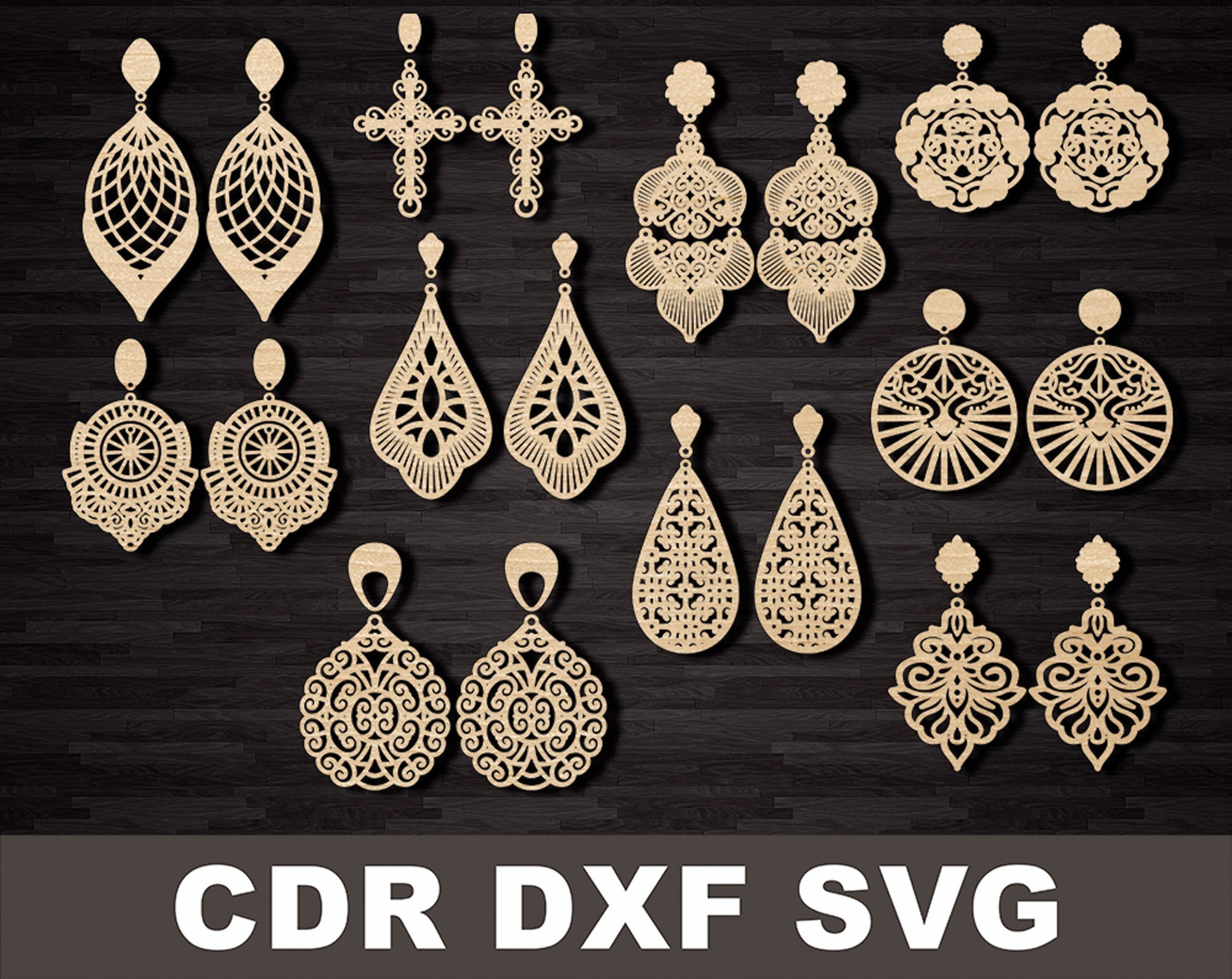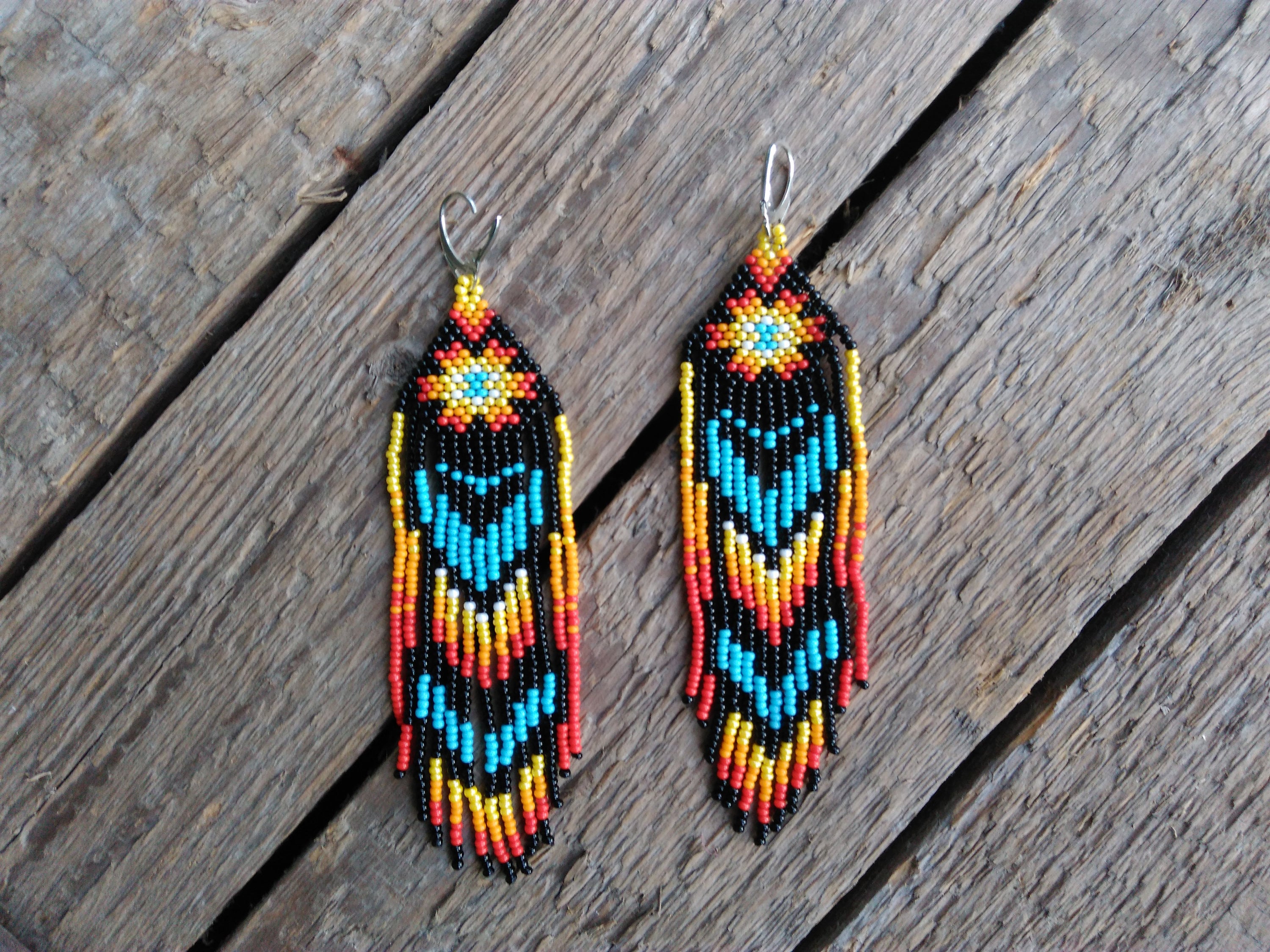Earring patterns jewelry has captivated hearts and adorned ears for centuries, transcending cultures and time periods. From intricate studs to dazzling chandeliers, these adornments hold a unique place in the world of fashion and self-expression. Join us on a journey through the captivating realm of earring patterns jewelry, where we explore their historical significance, design elements, and ever-evolving trends.
Design Elements

The design elements of earrings are crucial in determining their overall appearance and appeal. These elements include shape, size, style, color, texture, and material.
The shape of earrings can vary greatly, from simple studs to elaborate hoops or danglers. The size of earrings can also range from tiny studs to large, statement-making pieces. The style of earrings can be classic, modern, bohemian, or anything in between.
Shapes
- Studs: Small, single-piece earrings that are typically worn close to the earlobe.
- Hoops: Circular or oval-shaped earrings that come in a variety of sizes and thicknesses.
- Danglers: Earrings that hang from the earlobe, often featuring multiple components or embellishments.
- Chandeliers: Elaborate, multi-tiered earrings that resemble chandeliers.
- Geometric: Earrings featuring angular or geometric shapes, such as triangles, squares, or hexagons.
Sizes
The size of earrings can vary significantly, from tiny studs that are barely noticeable to large, statement-making pieces that draw attention. The size of earrings should be chosen based on personal preference and the occasion for which they are being worn.
Styles
The style of earrings can range from classic and timeless to modern and trendy. Classic styles include studs, hoops, and pearl earrings. Modern styles include geometric earrings, asymmetrical earrings, and earrings with unique embellishments.
Historical Significance

Earrings have adorned the ears of humans for centuries, carrying both cultural and historical significance. Their origins can be traced back to ancient civilizations, where they were not merely accessories but held profound meanings and played specific roles in society.
In ancient Egypt, earrings were symbols of wealth, status, and power. They were crafted from gold, silver, and lapis lazuli, and often featured intricate designs. Pharaohs and other members of the elite wore large, elaborate earrings as a display of their authority.
In contrast, commoners wore simpler earrings made of bone, wood, or copper.
Symbolism and Meaning
Throughout history, earrings have been imbued with various symbolic meanings. In some cultures, they were believed to ward off evil spirits or protect the wearer from harm. In others, they were associated with fertility, marriage, or social status. For example, in ancient Rome, married women wore hoop earrings as a symbol of their marital status.
Types of Earring Patterns

Earring patterns come in a wide array of styles, each with its own unique characteristics. From the classic elegance of studs to the dramatic flair of chandeliers, there’s an earring pattern to suit every taste and occasion.
To help you navigate the vast world of earring patterns, we’ve compiled a comprehensive table showcasing some of the most popular types, along with their descriptions, illustrations, and advantages and disadvantages:
Studs
- Description: Studs are small, single-piece earrings that are typically secured with a push back or screw-on closure.
- Illustration: [Insert illustration of stud earrings]
- Advantages: Studs are versatile and easy to wear, making them suitable for both everyday and formal occasions. They are also relatively affordable and come in a wide range of designs.
- Disadvantages: Studs can be difficult to put on and take off, especially if you have long nails or limited dexterity.
Hoops
- Description: Hoops are circular earrings that come in a variety of sizes and thicknesses. They are typically made of metal, but can also be made of other materials such as plastic or wood.
- Illustration: [Insert illustration of hoop earrings]
- Advantages: Hoops are a classic and timeless earring style that can add a touch of glamour to any outfit. They are also relatively easy to put on and take off.
- Disadvantages: Hoops can be heavy, especially if they are large or made of a heavy material. They can also be uncomfortable to wear for long periods of time.
Dangles, Earring patterns jewelry
- Description: Dangles are earrings that have a drop or pendant that hangs from the earlobe. They can be made of a variety of materials, including metal, gemstones, and beads.
- Illustration: [Insert illustration of dangle earrings]
- Advantages: Dangles are a versatile earring style that can add a touch of movement and personality to any outfit. They are also relatively easy to put on and take off.
- Disadvantages: Dangles can be heavy, especially if they are large or made of a heavy material. They can also be uncomfortable to wear for long periods of time.
Chandeliers
- Description: Chandeliers are elaborate earrings that are typically made of multiple tiers of gemstones or beads. They are typically worn for special occasions, such as weddings or black-tie events.
- Illustration: [Insert illustration of chandelier earrings]
- Advantages: Chandeliers are a stunning and eye-catching earring style that can make a statement. They are also relatively easy to put on and take off.
- Disadvantages: Chandeliers can be heavy and uncomfortable to wear for long periods of time. They are also more expensive than other earring styles.
Material and Craftsmanship: Earring Patterns Jewelry

The creation of earrings involves a wide array of materials and craftsmanship techniques, each contributing to the durability, aesthetic appeal, and value of the final product.
Materials commonly used in earring making include:
- Gold: A precious metal known for its luster, malleability, and resistance to corrosion.
- Silver: A precious metal with a lustrous white appearance and good durability.
- Gemstones: Precious or semi-precious stones, such as diamonds, rubies, emeralds, and sapphires, add color, brilliance, and value to earrings.
- Beads: Small, decorative elements made from various materials, such as glass, wood, or metal, that can add texture and visual interest.
Craftsmanship techniques employed in earring making include:
- Casting: A process of pouring molten metal into a mold to create the desired shape.
- Soldering: A technique used to join two pieces of metal by melting a lower-melting-point metal between them.
- Wirework: The art of shaping and manipulating wire to create intricate designs and components.
The durability and quality of earrings depend on the materials used and the craftsmanship techniques employed. For example, gold and silver are highly durable and resistant to wear, while gemstones and beads may require more delicate handling. The skill and experience of the craftsperson also play a significant role in the overall quality of the earrings.
Styling and Trends

Earring trends and styles are ever-evolving, influenced by fashion designers, celebrities, and cultural shifts. Earrings can complement any outfit, adding a touch of elegance, glamour, or individuality.
When pairing earrings with different outfits and occasions, consider the following factors:
- Formal Occasions:Opt for classic styles like studs, hoops, or chandelier earrings in precious metals or gemstones.
- Casual Wear:Choose playful or trendy designs, such as drop earrings, tassel earrings, or statement earrings.
- Special Occasions:For weddings, anniversaries, or other special events, go for statement pieces like chandelier earrings, long danglers, or ornate designs.
Popular Earring Trends
- Asymmetrical Earrings:Mismatched or unbalanced earrings that create a unique and edgy look.
- Oversized Earrings:Bold and eye-catching earrings that make a statement, often featuring chunky designs or vibrant colors.
- Hoop Earrings:A classic and versatile style, available in various sizes and metals, from delicate to chunky.
- Drop Earrings:Earrings that hang below the earlobe, featuring gemstones, beads, or other decorative elements.
- Ear Crawlers:Earrings that wrap around the earlobe or cartilage, creating a unique and eye-catching look.
Fashion designers and celebrities play a significant role in shaping earring trends. Designers showcase their latest earring designs on the runway, while celebrities often sport eye-catching earrings on red carpets and in street style.
Care and Maintenance
Proper care and maintenance of earrings ensure their longevity and preserve their beauty. By following these guidelines, you can keep your earrings looking their best for years to come.
Cleaning your earrings regularly is essential to prevent dirt and debris from accumulating. Use a soft cloth or a gentle brush to gently wipe away any surface dirt. For more thorough cleaning, you can use a mild soap solution and a soft toothbrush.
Be sure to rinse the earrings thoroughly with water afterward and pat them dry with a soft cloth.
Storing Earrings
Proper storage of earrings is crucial to prevent tarnishing and damage. Store earrings in a cool, dry place away from direct sunlight and moisture. You can use a jewelry box or a sealed plastic bag to keep earrings organized and protected.
Repairing Earrings
If your earrings become damaged, it is important to have them repaired by a professional jeweler. Do not attempt to repair earrings yourself, as this could further damage them. A jeweler can assess the damage and recommend the best course of action, whether it be a simple repair or a more extensive restoration.
Preventing Tarnishing
Tarnishing is a common problem that can affect earrings over time. To prevent tarnishing, avoid exposing earrings to harsh chemicals, such as chlorine or bleach. You can also apply a thin layer of clear nail polish to the metal parts of earrings to create a protective barrier.
Outcome Summary

As we conclude our exploration of earring patterns jewelry, we are left with a profound appreciation for their beauty, versatility, and cultural significance. Whether you prefer the timeless elegance of studs or the bold statement of chandeliers, earrings have the power to transform an outfit and elevate your personal style.
Embrace the artistry and history behind these exquisite adornments, and let them become a cherished part of your jewelry collection.
FAQ Corner
What are the most popular earring patterns?
Some of the most popular earring patterns include studs, hoops, dangles, and chandeliers.
How should I choose the right earring pattern for my face shape?
The shape of your face can help you determine which earring patterns will complement your features. For example, studs and small hoops are generally flattering on most face shapes, while larger dangles or chandeliers may be more suitable for oval or oblong faces.
How can I care for my earring patterns jewelry?
To keep your earring patterns jewelry looking its best, clean it regularly with a soft cloth and store it in a dry place. Avoid exposing your jewelry to harsh chemicals or moisture, as this can damage the metal or gemstones.
